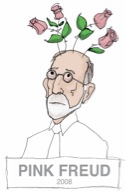Published: September 29, 2009
 When you have been practicing psychology as long as I have, it is easy to question new therapies when you discover them. Well this weekend this notion of mine was put to the test! My wife and I were staying in Naramata with some good friends! It was our intent to tour (and sample) some of B.C.’s best wineries.
When you have been practicing psychology as long as I have, it is easy to question new therapies when you discover them. Well this weekend this notion of mine was put to the test! My wife and I were staying in Naramata with some good friends! It was our intent to tour (and sample) some of B.C.’s best wineries.
On Saturday we visited 8 wineries; one stood out, somehow by sheer coincidence we stumbled upon ˜Therapy Vineyards. Imagine my delight!
 There I sampled the ˜Freudian Sip, Pink Freud, and Super Ego Magic! However, I did leave with a bit of an inferiority complex. The therapy offered here was cheaper than anything I offer, tasted divine, and left me feeling warm and fuzzy. If an Englishman’s gin bottle is his castle – Therapy Vineyards is my favoured retreat.
There I sampled the ˜Freudian Sip, Pink Freud, and Super Ego Magic! However, I did leave with a bit of an inferiority complex. The therapy offered here was cheaper than anything I offer, tasted divine, and left me feeling warm and fuzzy. If an Englishman’s gin bottle is his castle – Therapy Vineyards is my favoured retreat.
Now all that’s left for me is to work out how to turn my next visit into a double-blind study!
** Rumpole
Published: September 29, 2009
Do men and woman have different senses of humor?Robert Mankoff, the cartoon editor of The New Yorker, explains how each gender tends to use humor differently: women use it to share something about themselves, and men use it to hide something about themselves.
Source: Big Think
Published: September 29, 2009
The live webcast of the Vancouver Peace Summit began at 9:00am PDT.
link to this webcast
9:00am – 10:00am PDT: Creativity and Well-being
The Dalai Lama, Sir Ken Robinson, Daniel Segal, Matt Goldman (Blue Man Group), Eckhart Tolle, Murray Gell-Mann. Moderator: Matthieu Ricard
10:00am – 11:00am PDT: Heart-Mind Education: Enhancing academic, social, and emotional competence
The Dalai Lama, Clyde Hertzman, Kim Schonert-Reichl, Adele Diamond, Stephen Covey, Mairead Maguire. Moderator: Martha Piper
2:00pm – 4:00pm PDT: Women and Peace-building
The Dalai Lama, Jody Williams, Kim Campbell, Ashley Judd, Fazle Hasan Abed, Swanee Hunt, Laureen Powell Jobs.
Source: TED
Published: September 29, 2009
Love has inspired countless works of art, from immortal plays such as Romeo and Juliet, to architectural masterpieces such as the Taj Mahal, to classic pop songs, like Queen’s “Love of My Life”. This raises the obvious question: why is love such a stimulating emotion? Why does the act of falling in love – or at least thinking about love – lead to such a spur of creative productivity? Link to continue reading
Source: Scientific American
 When you have been practicing psychology as long as I have, it is easy to question new therapies when you discover them. Well this weekend this notion of mine was put to the test! My wife and I were staying in Naramata with some good friends! It was our intent to tour (and sample) some of B.C.’s best wineries.
When you have been practicing psychology as long as I have, it is easy to question new therapies when you discover them. Well this weekend this notion of mine was put to the test! My wife and I were staying in Naramata with some good friends! It was our intent to tour (and sample) some of B.C.’s best wineries. There I sampled the ˜Freudian Sip, Pink Freud, and Super Ego Magic! However, I did leave with a bit of an inferiority complex. The therapy offered here was cheaper than anything I offer, tasted divine, and left me feeling warm and fuzzy. If an Englishman’s gin bottle is his castle – Therapy Vineyards is my favoured retreat.
There I sampled the ˜Freudian Sip, Pink Freud, and Super Ego Magic! However, I did leave with a bit of an inferiority complex. The therapy offered here was cheaper than anything I offer, tasted divine, and left me feeling warm and fuzzy. If an Englishman’s gin bottle is his castle – Therapy Vineyards is my favoured retreat.